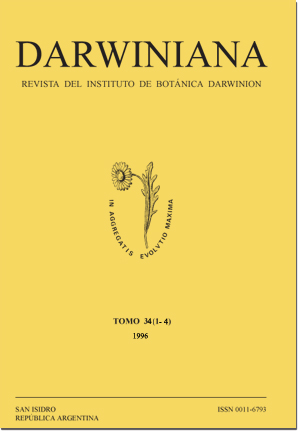Reproductive biology of Panicum spathellosum (Poaceae: Panicoideae: Paniceae).
DOI:
https://doi.org/10.14522/darwiniana.2014.341-4.413Abstract
Reproductive biology of Panicum spathellosum Döll was studied in two natural populations from Buenos Aires province, Argentina. In this species the inflorescences are composed of biflowered spikelets. The opening of the flowers is basipetal both in the principal and primary axis. Each spikelet has a lower staminate flower and an upper pistillate, chasmogamous and protogynous flower. The latter has also 3 staminodia. The stigmatic branches of the upper flower were exposed and 1 day later the staminodia arose. All the stigmas were exposed in approximately 8 days. Afterwards the stamens of each lower flower appeared and the entire exposition was completed in 3 days. It took nearly 13 days between the presentation of the stigmatic branches to the whole emergence of the androecium.Pollen grains had an 85.5 % of viability and contained starch, proteins and lipids as reserve substances. Some experiences were made to analyze the reproductive system of this species. It was proved that it is cross-pollinated and there was neither geitonogamy nor apomixis. A 60-81 % of caryopsis formation was obtained by cross-pollination, Caryopsis showed a 75 % of germination after sowing. A new type of "sexuality" within the spikelet of Panicum is here described. In P. spathellosum the lower flower is staminate and the upper one pistillate. The present study suggests that P. spathellosum has improved cross-pollination throughout diclinous monoecy and temporal separation of floral anthesis.
Downloads
Published
31-12-2011
How to Cite
Vega, A. S. (2011). Reproductive biology of Panicum spathellosum (Poaceae: Panicoideae: Paniceae). Darwiniana, Nueva Serie, 34(1-4), 199–211. https://doi.org/10.14522/darwiniana.2014.341-4.413
Issue
Section
Reproductive Biology
License

Starting on 2012, Darwiniana Nueva Serie uses Licencia Creative Commons Atribución-NoComercial 2.5 Argentina .






